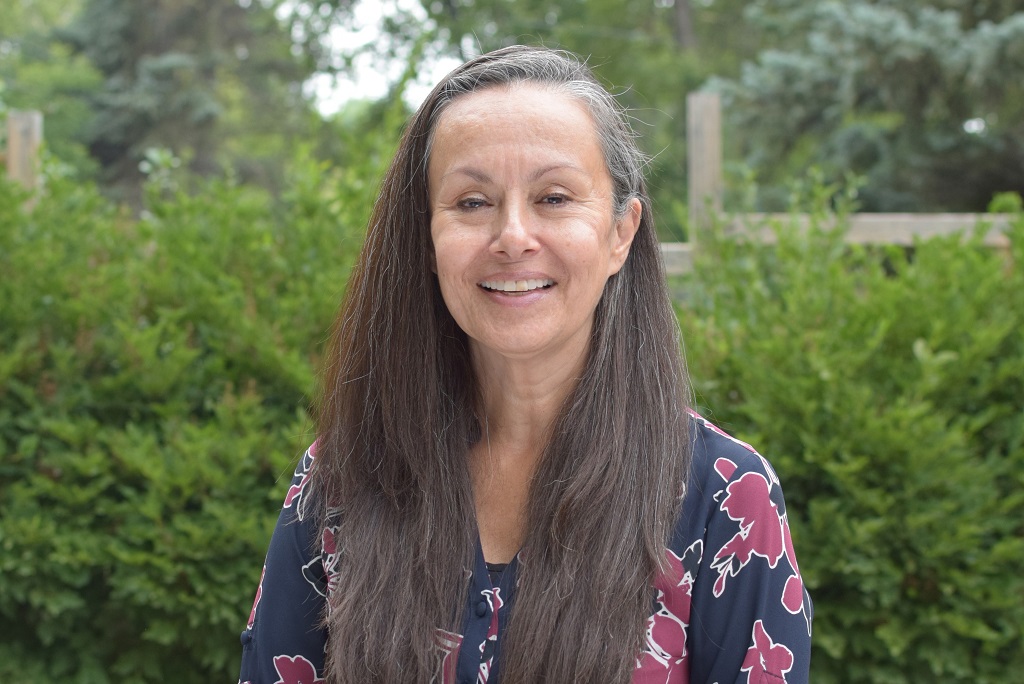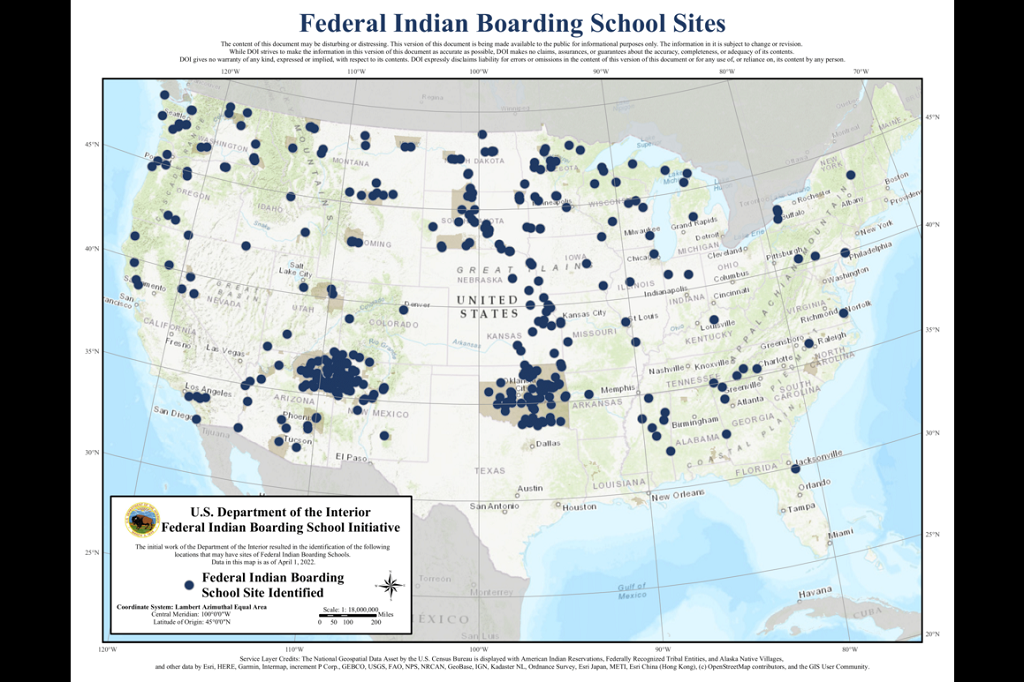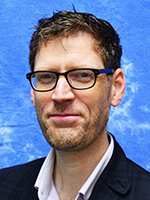Truth and reconciliation
Major federal report on American Indian boarding schools relies heavily on work by Ursula Running Bear of UND

By Brian James Schill
Although its carcinogenic effects were known at least by the early 1960s, the chemical dichlorodiphenyltrichloroethane, or DDT, was not banned for agricultural use in the United States until 1972.
Exactly when the ban made its way to U.S. boarding schools is less clear.
For decades, says Ursula Running Bear, assistant professor in the Department of Population Health at the UND School of Medicine & Health Sciences, American Indian children brought to at least some of these English language-only schools in the past two centuries were showered with the chemical upon arrival.
“They had to wear DDT,” she says with a grimace. “In some instances, it was for a week up front, and then once more every year after that [students] were required to wear it.”
A culture of deculturation
No surprise, then, that attendees of such schools were and are much more likely to develop a variety of debilitating and/or fatal health conditions — including cancer, anemia, arthritis, and gall bladder disease — than non-attendees.
Such is the focus of Running Bear’s research at the SMHS: the health effects of boarding school attendance among Indigenous populations. And as this anecdote suggests, the data are clear and the outcomes disconcerting: boarding school attendance correlates directly and significantly with poorer health among American Indian populations.
Beginning with the Indian Civilization Act of 1819, the U.S. systematized the “deculturation” of Indigenous children, primarily by establishing boarding school across the nation and often forcibly relocating children to faraway schools for the purposes of assimilation into Anglo-American society — cutting their hair, forbidding Indigenous language use and keeping them isolated from family.
By 1902, the U.S. Bureau of Indian Affairs had established 25 federally funded off-reservation schools in 15 states and territories, often managed by religious institutions, with an enrollment of as many as 25,000 students. At one point, federal law even required American Indian children to be educated at such schools according to American standards.
Today, most such schools in North America have been returned to the tribes or have permanently closed. But the physical and emotional impact of forced attendance remains, both for those who attended such schools and their descendants.
“[The research] shows overwhelmingly that those who attended boarding school have lower physical health status,” says Running Bear, who can identify three generations worth of her own ancestors who attended a boarding school. “I looked at 15 chronic conditions and found seven of them among former attenders was higher in a way that was statistically significant.”
Diet and exercise were the leading culprits in contributing to poor health in Indigenous children — and later adults.
“Children were used to living off the land, hunting, and eating food that the tribes grew themselves,” Running Bear explains. “And then they were put into boarding schools where the food had high sugar content — refined flours, lard, and a lack of fresh fruit and vegetables. It was very different.”
But even more distressing, the researcher says, were the long-term health effects of the trauma that boarding schoolers also suffered.
“It turns out that if you had certain types of experiences, you have lower physical health status,” she continues. “So, for instance, if you had limited family visits, you have much lower health status now. If you were forced to attend [Christian] church services, weren’t allowed to practice your cultural traditions, and weren’t allowed to speak your language — all of those things are associated with much worse physical health.”

Grim discovery
Despite the gravity of such results, Running Bear admits that it was initially difficult to find a large and engaged audience for her reports. Then some long-shuttered boarding schools in Canada hit the news last year following a grim discovery.
Early in 2021, Canada’s Tk’emlúps te Secwepemc First Nation reported finding evidence of a mass grave containing the remains of up to 215 children buried at the Kamloops Indian Residential School in British Columbia.
As the New York Times contextualized the find, starting in the 19th century, Canada was, like the U.S., home to a system of “residential” schools, “mostly operated by churches, that Indigenous children were forced to attend.”
After the last school closed in 1996, according to the Times, a “National Truth and Reconciliation Commission, set up as part of a government apology and settlement over the schools, concluded that at least 4,100 students died while attending the schools, many from mistreatment or neglect, others from disease or accident. It found that in many cases, families never learned the fate of their offspring, who are now known as the missing children.”
As it turns out, such deaths at boarding schools were common in both the U.S. and Canada with children perishing far too often from disease, accidents, malnutrition and other even more dreadful reasons such as physical abuse.
So it is that in May 2022, U.S. Interior Secretary Deb Haaland, an enrolled member of the Laguna Pueblo tribe in New Mexico, released its Federal Indian Boarding School Initiative Investigative Report. This report came one year after Haaland had assembled her own Federal Indian Boarding School Initiative in the wake of the Canadian report.
At the core of the report is Running Bear’s work, which was called “watershed” research.
“As the Federal Indian boarding school system operated for over a century and a half, the Department identifies the watershed Running Bear studies, quantitative research based on now-adult Federal Indian boarding school attendees’ medical status, that indicate the Indian boarding school system continues to impact the present-day health of Indians who participated in the studies,” notes the federal report. “These results verify the need for a comprehensive examination and report by an independent research group to assess the current impacts that Indian boarding schools have had on American Indians, Alaska Natives, and Native Hawaiians, including health, education and economic status.”
The right direction
Such a recognition, at the federal level, tells Running Bear that things are going in the right direction generally — not only for her research but for the nation.
“I listened in on the Oversight Hearing [Volume 1 of the Department of the Interiors’ Federal Indian Boarding School Initiative Investigative Report and Legislative Hearing to receive testimony on S.2907] with Deb Haaland, and the response from the government officials that were there was quite amazing, very open and very supportive,” admits Running Bear, who is Sicangu Lakota from the Rosebud Reservation in South Dakota. “I get kind of emotional to think about getting this kind of support from the government to actually help us address a problem like this. Haaland and her team are going to be touring various reservations. They are going to be talking to communities and I believe getting a testimony on what occurred [at the schools].”
Among the report’s many recommendations to Assistant Secretary of Indian Affairs Bryan Newland, and ultimately the U.S. Congress, are fuller research into federal boarding school abuses, support for Indigenous language revitalization and the promotion of research into Indigenous health disparities.
“I was a little surprised, although I knew that [the schools] used harsh methodologies for kids speaking Native languages for example — there was imprisonment and all of these different things that occurred in boarding schools,” Running Bear sighs. “But the fact that all of this was acknowledged in a public setting, in those words, was very surprising. My grandparents attended boarding schools, and then my parents’ generation and then even my own generation. So, this is a big deal.”

About the author:
Brian James Schill is director of Alumni & Community Relations at the UND School of Medicine & Health Sciences.


